Shuddhi is Sanskrit for purification. It is a term used to describe a Hindu religious movement aimed at the religious conversion of non-Hindus of Indian origin to Hinduism. [1]
The socio-political movement, derived from ancient rite of shuddhikaran, [2] or purification was started by the Arya Samaj, and its founder Swami Dayanand Saraswati and his followers like Swami Shraddhanand, who also worked on the Sangathan consolidation aspect of Hinduism, in North India, especially Punjab in early 1900s, though it gradually spread across India. [3] Shuddhi had a social reform agenda behind its rationale and was aimed at abolishing the practise of untouchability by converting outcasts from other religions to Hinduism and integrating them into the mainstream community by elevating their position, and instilling self-confidence and self-determination in them. [3] [4] [5] The movement strove to reduce the conversions of Hindus to Islam and Christianity, which were underway at the time. [3]
In 1923, Swami Shraddhanand founded the 'Bhartiya Hindu Shuddhi Mahasabha' (Indian Hindu Purification Council) and pushed the agenda of reconversion, which eventually created a flashpoint between Hindus and Muslims as Hindus were the recipients of the violence.[ citation needed ]. Mahatma Gandhi made a comment on Swami Shraddhananda in an article titled 'Hindu-Muslim-Tensions: Causes and Resistance' in the May 29, 1922 issue of Young India.
Swami Shraddhananda has also become a character of disbelief. I know that his speeches are often provocative. Just as most Muslims think that every non-Muslim will one day convert to Islam, Shraddhananda also believes that every Muslim can be initiated into the Aryan religion. Shraddhananda Ji is fearless and brave. He alone has built a great Brahmacharya Ashram (Gurukul) in the holy Ganges. But they are in a hurry and it will move soon. He inherited it from the Aryan society.
Gandhi further wrote Dayanand that "he narrowed one of the most liberal and tolerant religions of the world." Swami responded to Gandhi's article that "If Arya Samaji is true to themselves, then the allegations of Mahatma Gandhi or any other person and invasions also cannot obstruct the trends of Arya Samaj." Shraddhanand followingly kept moving towards his goal.
The main point of contention was the reconversion of Malkana Rajputs in western United Province. [6] As a result, the movement became controversial and antagonized the Muslims populace [4] and also led to the assassination of the leader of the movement, Swami Shraddhanand by a Muslim in 1926. After Swami Shraddhanand died this movement continued. [7]
In the late 1920s, prominent Goan Hindu Brahmins requested Vinayak Maharaj Masurkar, the prelate of a Vaishnava Ashram in Masur, Satara district; to actively campaign for the 're-conversion' of Catholic Gaudas to Hinduism. [8] Masurkar accepted, and together with his disciples, subsequently toured Gauda villages singing devotional bhakti songs and performing pujas . [8] These means led a considerable number of Catholic Gaudas to declare willingness to come into the Hindu fold, and a Shuddhi ceremony was carefully prepared. [8] On 23 February 1928, many Catholic Gaudes in Goa were re-converted to Hinduism notwithstanding the opposition of the Church and the Portuguese government. [9] The converts were given Sanskrit Hindu names, but the Portuguese government put impediments in their way to get legal sanction for their new Hindu names. [10] 4851 Catholic Gaudes from Tiswadi, 2174 from Ponda, 250 from Bicholim and 329 from Sattari were re-converted to Hinduism after nearly 400 years. The total number of the converts to Hinduism was 7815. [11] The existing Hindu Gauda community refused to accept these neo-Hindus back into their fold because their Catholic ancestors had not maintained caste purity, and the neo-Hindus were now alienated by their former Catholic coreligionists. [12] These neo-Hindus developed into a separate endogamous community, and are now referred to as Nav-Hindu Gaudas (New Hindu Gaudas). [13]
However, in Northern India this movement faced stiff opposition from Islamic organizations such as the Barelvi movement's Jama'at Raza-e-Mustafa which attempted to counter the efforts of the Shuddhi movement to convert Muslims to Hinduism in British India. [14]
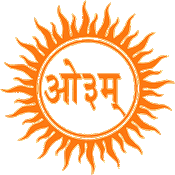
Arya Samaj is a monotheistic Indian Hindu reform movement that promotes values and practices based on the belief in the infallible authority of the Vedas. The samaj was founded by the sannyasi (ascetic) Dayanand Saraswati in the 1870s.
Contemporary groups, collectively termed Hindu reform movements, reform Hinduism, Neo-Hinduism, or Hindu revivalism, strive to introduce regeneration and reform to Hinduism, both in a religious or spiritual and in a societal sense. The movements started appearing during the Bengali Renaissance.
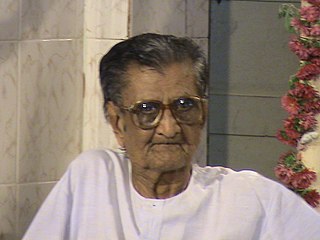
Pandit Sudhakar Chaturvedi was an Indian independence activist, Vedic scholar, Indologist, and claimed supercentenarian. At the claimed age of 122 years, 313 days, some Indian newspapers reported him as the oldest Indian ever.
Pandit Shri Krishna Sharma was an Arya Samaj preacher who came to Fiji in 1926 from Rajkot, India. He was a gifted public speaker and singer of religious songs. He provided impetus to the Arya Samaj movement in Fiji. Under his influence Arya Samaj schools and temples were established in Fiji. He was responsible for the establishment of the Hindu Maha Sabha for the purpose of uniting all Hindus in Fiji. He advocated shuddhi and this caused conflict with Muslims and Christians in Fiji.
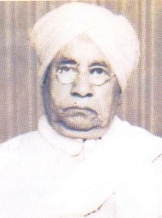
Thakur Kundan Pal Singh Kush (1881–1967) was an Arya Samaj missionary and teacher who arrived in Fiji, from Muzaffarnagar, Uttar Pradesh, India in 1928. He first taught at the Dharamshala School in Nausori where he later became the founding Head Teacher of Vunimono Arya School in 1929. He taught in a number of Arya Samaj schools which included Gurukul Primary School near Lautoka in 1939, Arya Samaj Girls' School in Saweni, Lautoka, from 1940 to 1945, Swami Shraddanand Memorial School in Suva, Vunikavikaloa Arya School in Ra, and Veisari Primary School near Suva.
Hindu Maha Sabha was an organisation representing various Hindu organisations and was formed in Fiji in 1926, following the formation of All-India Hindu Maha Sabha in India. The formation of the organisation both in India and Fiji occurred after the assassination of Swami Shraddhanand, a Hindu activist in India. The formation of the Sabha in Fiji coincided with the formation of a national Muslim organisation, the Fiji Muslim League.
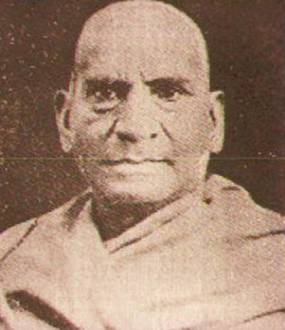
Swami Shraddhanand, also known as Mahatma Munshi Ram Vij, was an Arya Samaj sannyasi and an Indian Independence activist who propagated the teachings of Dayananda Saraswati. This included the establishment of educational institutions, like the Gurukul Kangri University, and played a key role on the Sangathan and the Shuddhi (purification), a Hindu reform movement in the 1920s.
Sanātana Dharma is an alternative term used by some Hindus to refer to Hinduism instead of the mainstream term Hindu Dharm. The term is found in Sanskrit and other Indian languages. It is generally used to signify a more traditional, pre-reform outlook of Hinduism.
Adi Dharm refers to the religion of Adi Brahmo Samaj the first development of Brahmoism and includes those Sadharan Brahmo Samajists who were reintegrated into Brahmoism after the second schism of 1878 at the instance of Devendranath Tagore. This was the first organised casteless movement in British India and reverberated from its heart of Bengal to Assam, Bombay State, Punjab and Madras, Hyderabad, and Bangalore.
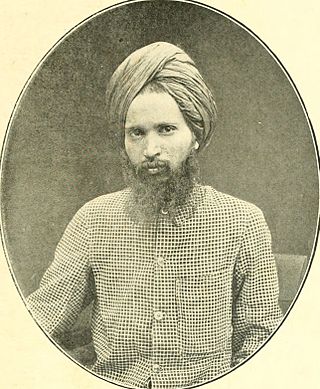
Lala Hansraj also known as Mahatama Hansraj, was an Indian educationist and a follower of Arya Samaj movement founder, Swami Dayanand. He founded, with Gurudatta Vidhyarthi, the Dayanand Anglo-Vedic Schools System (D.A.V.) in Lahore on 1 June 1886, where the first D.A.V. school was set up in memory of Dayanand who had died three years earlier.

The indigenous population of the erstwhile Portuguese colony of Goa, Daman and Diu underwent Christianisation following the Portuguese conquest of Goa in 1510, which was followed by the Goa Inquisition from 1560 onwards. The converts in the Velhas Conquistas to Roman Catholicism were then granted full Portuguese citizenship. Almost all present-day Goan Catholics are descendants of these native converts; they constitute the largest Indian Christian community of Goa state and account for 25 percent of the population.
The Malkana are a Muslim ethnic group found in the states of Uttar Pradesh and Bihar of India.
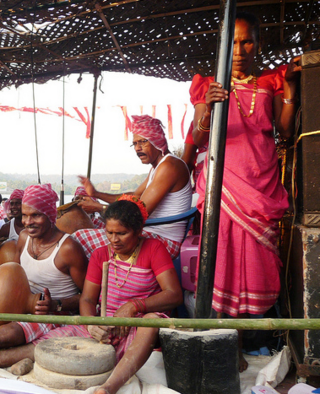
Gaudas are aboriginal people residing in the coastal Indian state of Goa. They are believed to be the original inhabitants of Konkan. Most follow folk Hinduism, but many were converted to Catholicism by the Portuguese missionaries during the Christianisation of Goa while still keeping their folk tradition and culture alive.

The Singh Sabhā Movement, also known as the Singh Sabhā Lehar, was a Sikh movement that began in Punjab in the 1870s in reaction to the proselytising activities of Christians, Hindu reform movements and Muslims. The movement was founded in an era when the Sikh Empire had been dissolved and annexed by the British, the Khalsa had lost its prestige, and mainstream Sikhs were rapidly converting to other religions. The movement's aims were to "propagate the true Sikh religion and restore Sikhism to its pristine glory; to write and distribute historical and religious books of Sikhs; and to propagate Gurmukhi Punjabi through magazines and media." The movement sought to reform Sikhism and bring back into the Sikh fold the apostates who had converted to other religions; as well as to interest the influential British officials in furthering the Sikh community. At the time of its founding, the Singh Sabha policy was to avoid criticism of other religions and political matters.
Hindu nationalism has been collectively referred to as the expression of social and political thought, based on the native spiritual and cultural traditions of the Indian subcontinent. "Hindu nationalism" is a simplistic translation of हिन्दू राष्ट्रवाद. It is better described as "Hindu polity".
Ghar Wapsi is the programme of religious conversion to Hinduism from Islam, Christianity, and other religions in India conducted by Indian Hindu nationalist organisations Vishva Hindu Parishad (VHP), Rashtriya Swayamsevak Sangh (RSS) and their allies. The term owes to the Hindu nationalist ideology that all people of India are ancestrally Hindu and, hence, conversion to Hinduism is one of "returning home" to their ancestral roots.
Swami Achhootanand, also known as Achutanand or Hariharanand, was a 20th century Indian anti-caste intellectual, Dalit writer, and social reformer. A former Arya Samajist, he became disillusioned with the Arya Samaj and established the Adi Hindu movement. He was a poet, critic, dramatist, and historian.
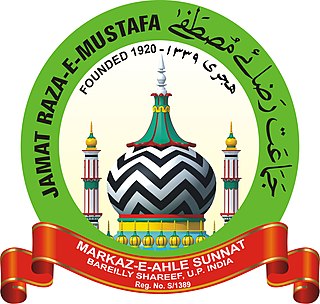
Jamat Raza-e-Mustafa also known as JRM, is a historical organisation of Indian Sunni Barelvi Muslims associated with Sufism. It was founded by scholar and 19th-century Mujadid Ahmed Raza Khan Barelvi on 17 December 1920 in Bareilly, India, to propagate Islamic teachings in accordance with Ahle Sunnah wal Jama'ah. The self-described aim of the group is to "deny misguided sects and safeguard the beliefs (Aqaa'id) of the Ahle Sunnah wal Jama'ah."
Sanātanī is a modern term used to describe Hindu duties that incorporate teachings from the Vedas, Upanishads, Puranas, and other Hindu religious texts and scriptures such as the Ramayana and its many versions, as well as the Mahabharata, which itself is often described as a concise guide to Hindu philosophy and a practical, self-contained guide to life. The word Sanātanī is coined from Sanātana Dharma which refers to the idea that its origins lie beyond human history, as revealed in the Hindu texts.
Ishwardatt Medharthi (1900-1971) was an Indian religious leader, anti-caste social reformer, and independence activist. Born in a low-caste Arya Samaji family, he attended the Gurukul Kangri school for 14 years. He served time in prison for participating in the Bardoli Satyagraha (1929) and the Salt March (1930). After being released from prison, he ran a school in Kanpur and wrote books criticizing the caste-based discrimination. He turned to Buddhism in the 1930s, and taught Pali language to the Dalit leader B. R. Ambedkar in the 1940s. Later, he came under the influence of the Baháʼí Faith, and returned to the Arya Samaj during his last years.